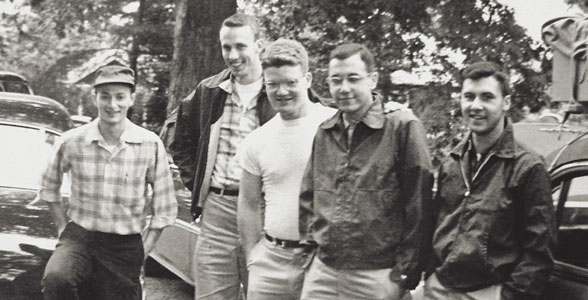In 1956, on a lark and with a lust for adventure, five UT students departed Knoxville for Alaska, where they spent the summer working in a gold mine.
The Territory of Alaska, still 3 years shy of statehood, was a sparsely populated frontier of less than 200,000 people. The heaviest traffic on the only highway between Fairbanks and Anchorage occurred in July, when an average of 42 vehicles a day traveled the road. Oil would not be discovered at Prudhoe Bay for a dozen years yet. Almost all roads were unpaved, and a guardrail was a novelty. Gas pumps were scarce. Despite carrying three jerrycans of gas in the trunk of the car, the men ran out of gas four times. After a summer of hard work and unending daylight, they returned to Tennessee with the tusk of a woolly mammoth atop their car. Today the 150-pound tusk is on display in UT’s McClung Museum, where three of the adventurers recently regrouped and reminisced.
John d’Armand, who now lives in Alaska, instigated the reunion and tusk-viewing when he returned to Knoxville for a visit last spring. With him at the museum, at the invitation of Dr. Thomas Broadhead of the Earth and Planetary Sciences Department, were Gene Fair and George Dominick of Knoxville. The other surviving member of the group, Knox Williams, lives in Wheaton, Illinois. The fifth traveler, Paul Dominick, George’s cousin, died 10 years ago. The five attended Knoxville’s Tyson Junior High School together and were graduated from West High School. They all pledged Phi Gamma Delta at UT, but d’Armand dropped out of the fraternity and joined the Independent Students Association.
The Knoxville natives drove to Alaska in d’Armand’s father’s 1949 Packard.
“It was a beautiful car,” d’Armand remembers. But the Packard was poorly suited for the mud and gravel roads–the Alcan Highway (now called the Alaska Highway) was still in its infancy–and was so bunged up when the round trip was over that the elder d’Armand sold it for just $35.
The five stuck together after arriving in Fairbanks. “We were hired as point drivers by the Fairbanks Expedition of United States Smelting, Refining, and Mining Company to work in a dredge mine farther north,” d’Armand says. “We worked nine hours a day, six days a week in ankle-deep water.” The workers were called point drivers after the machines that they operated. Point drivers were small pile drivers, which drilled 40 feet into the permafrost to thaw it with water so the dredge could claw through the soil. The friends earned less than $100 a week for their labor. Their dwelling was a tent cabin heated by a woodstove, “whose fire invariably burned out by two o’clock or so” every morning, d’Armand says. Already suffering from bronchitis because of cold nights of sleeping on the ground en route to Alaska, d’Armand left the mine after a short time and was hospitalized briefly. He spent the rest of the summer working in a salmon cannery on the Kenai River and as deckhand aboard various vessels in the Gulf of Alaska. The other friends continued working at the dredge mine, and it was there one day that they saw the mammoth tusk unearthed by the mining equipment.
“A guy was walking away with it over his shoulder, and we offered him three dollars for it,” Fair recalls. It wasn’t long before the unwieldy souvenir was southbound to Tennessee atop d’Armand’s car, driven by Fair and Williams. The Dominick cousins already had flown home.
At the end of the season, d’Armand, having worked his way to Seattle aboard a salmon tender, hitchhiked 1,200 miles up the desolate Fraser River Canyon to Fort Nelson, British Columbia, watching for his friends, who were returning from Fairbanks. “Since there was only one road in the area, they would be hard to miss. When I saw my car, it was carrying the mammoth tusk.”
When the young men returned to Knoxville, Williams donated the $3 tusk–a bargain remnant of the Pleistocene Epoch–to the UT Geology Department. Today it’s part of a permanent archaeology exhibit at McClung Museum.
Now in their seventies, the men retain a spark of the youthful optimism that took them to Alaska. George Dominick, retired from the electrical supply business, is a lifelong amateur-radio operator. His late cousin, Paul, owned Dominick’s Antiques in Knoxville. Fair is a dentist in Knoxville. Williams has a cabin near Townsend, Tennessee, where he spends a good deal of time. An accomplished singer, d’Armand began his career by touring and recording with the Robert Shaw Chorale, winning a Grammy Award in the process. He now lives in Auke Bay, Alaska, and is a professor of music at the University of Alaska.
The men share grins and guffaws and long-ago memories. They not only had a youthful grand adventure; they treasure the friendship of a lifetime.




